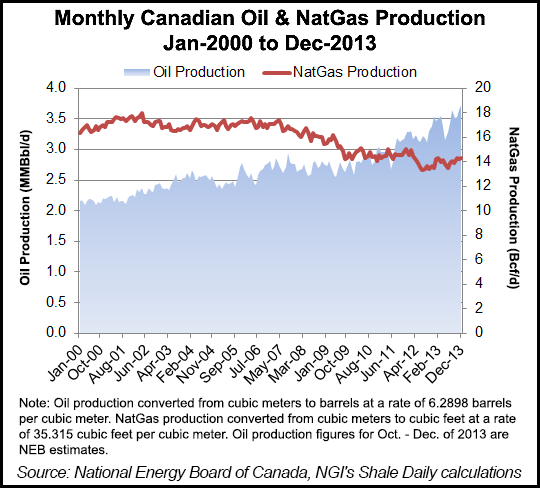E&P | NGI All News Access | NGI The Weekly Gas Market Report
Oil, Liquids, Gas Picking Up for Canadian Independents
Amid growing optimism that the energy economic cycle is taking a favorable turn, Canadian independent natural gas and oil producers are resuming building up supplies, largely by spreading the use of horizontal drilling and hydraulic fracturing.

A “wonderful sweet spot” of strong prices for both commodities is on the horizon, prominent Calgary analyst Josef Schachter told a company showcase held by the Explorers and Producers Association of Canada (EPAC). The annual event drew a record 500 representatives of financial and investment interests.
“There’s a chance we see another one coming in 2016 or ’17,” said Schachter. EPAC President Gary Leach agreed. “We’re feeling more bullish,” he said. They recited forces upholding gas prices since the severe 2013-2014 winter as well as enduring oil strength.
A wide spectrum of independent companies stepped forward as practical examples of the reviving optimism inspiring field activity across the Western Canada Sedimentary Basin in Alberta, British Columbia (BC) and Saskatchewan.
In southern Alberta, LGX Oil & Gas Inc. reported achieving initial flows nudging 450 b/d with horizontal wells and fracking in 110,000 acres (172 square miles) of previously untapped Canadian sections of the celebrated Bakken geological formation.
Under conservation regulation of the Alberta Energy Regulator (AER), a Bakken well settles down to 250 b/d. But the flows hold steady instead of rapidly tapering off because the virgin deposit is under high pressure that the AER rules preserve.
“Townships upon townships [36-square-mile survey divisions] are unexplored,” said LGX President Trent Yanko. “These are very, very economic wells” that typically find 370,000 bbl at a cost of C$6-7 million (US$5.4-6.3 million) apiece.
Yanko also reported encountering encouraging signs that Alberta’s share of the Bakken — as in North Dakota, South Dakota and Montana — is the top of a “stacked play” or geological layer cake. Alberta has underlying counterparts to the rich Three Forks zone in the United States, known as Exshaw, Banff and Big Valley. Other geological prospects — Second White Specks, Barons, Mannville and Nisku — also await exploration with the improved well technology, Yanko said.
In southern Saskatchewan, Raging River Exploration Inc. is dining out on a shallow, rapidly drilled and low-cost variety of horizontal drilling and fracking in a well-known but lately ignored formation called the Viking. Vertical drilling into the old Saskatchewan mainstay yields only mediocre results. But with repetitive use of standardized horizontal fracking wells, “This asset is a cash flow machine,” said Raging River’s Bruce Robertson, executive vice president.
For C$900,000 (US$810,000) a high-tech Viking well 700 meters (2,310 feet) down with a 600-meter (1,980-foot) horizontal leg can be drilled, completed and put into production in less than two weeks, Robertson said. Each Viking mineral rights survey section (one square mile) yields six to 16 million barrels of liquids. Raging River’s use of the technology taps each section with up to 16 horizontal bores radiating outward from surface well pads.
In northern Alberta and BC, where deep drilling and long horizontal well legs prevail, Kelt Exploration Ltd. President David Wilson said, “We’ve got a [geological] sweet spot. We’re not sure yet how big.” Horizontal drilling and fracking in Kelt’s share of the 90,000-square-kilometer (34,650-square-mile) Montney shale deposit yields 200 bbl of liquids for each 1 MMcf/d of gas.
Production from strong areas within the Montney is typically half liquids and half gas, and the best wells flow up to 65% premium light oil, said Wilson. The BC and Alberta governments both reward horizontal drilling and fracking with “holidays” from provincial royalties for initial flows that let Kelt recover total well costs in less than one year, added Wilson.
Although liquids are driving Montney drilling, the Canadian producers are becoming convinced that gas is poised to sweeten the rewards. “We’re quite bullish on natural gas,” said Wilson.
In the Canadian perspective gas only has to stay in its current Alberta trading range of C$4.00-4.50/gigajoule (GJ) (US$3.78-4.25/MMBtu) in order to score a major improvement on hard times as low as C$1.90/GJ (US$1.80/MMBtu) since the 2008-2009 recession.
“We’re pretty bullish on what could happen to natural gas prices this summer,” said Kelt Exploration CFO Sadiq Lalani. His outlook anticipates C$4.55/GJ (US$4.30/MMBtu), supported by healthy demand to refill storage depleted by the severe 2013-2014 heating season and to fuel power plants kept busy by summer air conditioning.
Schachter suggested a price rebound to annual averages in the area of C$7.00/GJ (US$6.62/MMBtu) or more is conceivable if heating seasons stay normal to cold, summers run warm or hot, and visions of growing use by power stations and liquefied natural gas exports come true.
© 2024 Natural Gas Intelligence. All rights reserved.
ISSN © 2577-9877 | ISSN © 1532-1266 | ISSN © 2158-8023 |
